Shine a Light Blu-ray Movie
HomeShine a Light Blu-ray Movie 
The Rolling StonesParamount Pictures | 2008 | 122 min | Rated PG-13 | Jul 29, 2008
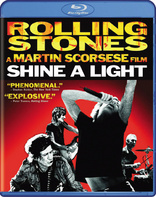
Movie rating
7.4 | / 10 |
Blu-ray rating
| Users | 4.6 | |
| Reviewer | 3.5 | |
| Overall | 4.1 |
Overview
Shine a Light (2008)
On April 4, 2008, an Academy Award-winning filmmaker and the world's greatest rock n' roll band will unite to bring audiences the year's most extraordinary musical film event, Shine a Light, to theaters everywhere. Martin Scorsese's concert documentary Shine a Light will show the world the Rolling Stones as they've never been seen before. Filming at the famed Beacon Theatre in New York City in fall 2006, Scorsese assembled a legendary team of cinematographers to capture the raw energy of the legendary band.
Starring: Mick Jagger, Keith Richards, Charlie Watts (I), Jack White (XV), Christina AguileraDirector: Martin Scorsese
| Music | Uncertain |
| Documentary | Uncertain |
Specifications
Video
Video codec: MPEG-4 AVC
Video resolution: 1080p
Aspect ratio: 1.78:1
Original aspect ratio: 1.85:1
Audio
English: DTS-HD Master Audio 5.1 (48kHz, 24-bit)
English: Dolby TrueHD 5.1 (48kHz, 24-bit)
English: LPCM 2.0 (48kHz, 16-bit)
Subtitles
English, English SDH, French, Spanish
Discs
50GB Blu-ray Disc
Single disc (1 BD)
Playback
Region free
Review
Rating summary
| Movie | 3.5 | |
| Video | 4.0 | |
| Audio | 4.0 | |
| Extras | 4.0 | |
| Overall | 3.5 |
Shine a Light Blu-ray Movie Review
Paramount's Blu-ray sets a new standard for concert footage, bringing the Stones from the Beacon Theater into your home.
Reviewed by Greg Maltz August 17, 2008Martin Scorsese is no stranger to rock concert films or documentaries of musicians. His classic film of The Band's farewell concert, The Last Waltz, and more recent documentary of Bob Dylan, No Direction Home, were unique in terms of quality and scope. But no concert footage previously placed in Scorsese's capable hands--or anyone else's, for that matter--can compare to the incredible presence and camerawork achieved in Shine a Light. Whatever you feel about the Rolling Stones, their talent and longevity, there is no escaping the technical merits of the angles and lighting. Scorsese gives you a view far better than the best seat in the house. At times, you're put up front of the crowd near the stage. Then you're in the air, sweeping across the Beacon Theater. Then you're onstage, surrounded by Mick Jagger, Keith Richards, Charlie Watts and Ron Wood. Shine a Light makes me wish all my favorite bands were captured like this (but in their prime) for Blu-ray release. While I fully appreciate the Stones and the quality of their Beacon performance, I just couldn't get past the fact that this was much ado about ancient rock gods, who I thought were over the hill when I saw them perform live in the '90s. As a celebration of rock icons, it works.
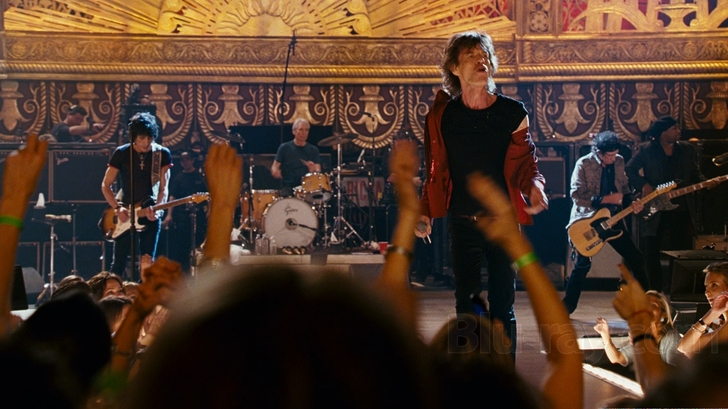
Martin Scorsese's treatment of recent Stones concerts puts the viewer in the Beacon Theater in New York. From a technical standpoint, this is probably the finest concert footage ever produced.
The Stones put on an inspired performance, as always, but it was the cabal of award-winning cinematographers behind the scenes who steal the show. The camera team includes Oscar-winners Robert Richardson (The Aviator), Robert Elswit (There Will Be Blood), Andrew Lesnie (Lord of the Rings) and John Toll (Legends of the Fall). Other notable cinematographers contributing to the film are Emmanuel Lubezki (Children of Men), Ellen Kuras (Summer of Sam), Stuart Dryburgh (The Piano) and Declan Quinn (Leaving Las Vegas). With experts like that behind the camera, it's little wonder that Scorsese achieves such an impressive presentation of the Beacon Theater concert. More importantly to rock fans, many of the Stones' greatest songs are performed, including "Sympathy for the Devil", "Tumbling Dice" and "Brown Sugar". Some interesting guests show up, too: legendary bluesman Buddy Guy, Christina Aguilera on "Live with Me" and Jack White (White Stripes) on "Loving Cup".
There is no escaping that the best material written by the Jagger/Richards duo comes from the '60s and '70s. Nor will anyone argue the point that the Stones look like ancient relics. So why would Scorsese and his team of ultratalented cinematographers focus their lenses on an over-the-hill band near the end of their career instead of a younger rock or pop group in their prime. For Scorsese, the answer is easy. He has always adored the Stones. Several of their songs were used in his films over the years. For him, Shine a Light is a labor of love. And, despite their age, the Stones rock as hard as ever and show passion and fire in their performance. Not many rock singers of any age can maintain Jagger's energy level for two hours onstage. While the production is at its best as simple concert footage, Scorsese does mix up the early part of the film by editing in black and white, older interviews with individual members of the band. This approach works. It shows younger viewers a glimpse of Jagger, Richards and Watts in their prime, and it generates more mystique as the performance itself gets underway.
As in the footage of The Last Waltz, Scorsese puts you in good hands. At all times he shows the angles you need to see and you never feel as though you're missing any important action. He even finds ways to work himself into the footage, and finishes the film with one of his long, trademark camera shots, first following a backstage pathway in the bowels of the Beacon, and then pulling away from outside the Beacon to a shot high above the Manhattan skyline. But it is the concert footage that really shines. Most filmmakers would have a problem tracking down a frontman as mobile as Jagger, who runs all over the stage throughout each concert, but Scorsese matches the mobility of the musicians with the skills of his cameramen. The result is captivating, ranging from sweeping shots on stage level to interesting angles looking up from the crowd. It sets a high watermark for concert footage, and the 1080p Blu-ray really does it justice here.
Shine a Light Blu-ray Movie, Video Quality 
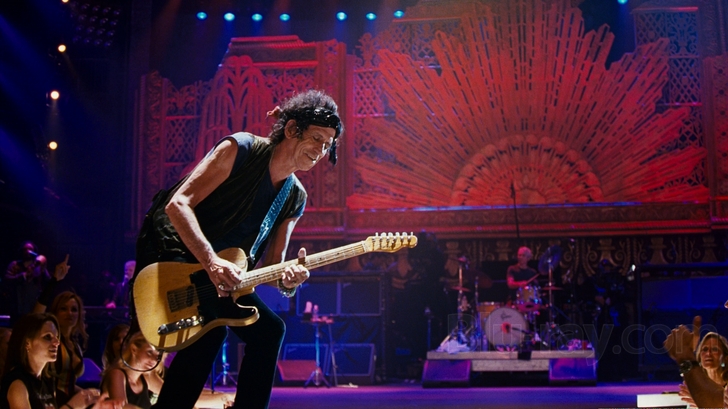
Paramount delivers another good encode, this time 1.78:1 ratio, using the MPEG-4 codec. Part of the intrigue of the video quality is Scorsese's use of digital, 16 mm and 35 mm content from different sources. The contrast is pumped up a bit to dramaticize the lighting in the Beacon Theater. Spotlights and backlights play a major role in the picture. The colors appear very rich and when the lights are dim, the inky black level becomes apparent, as does some noise and grain. Unfortunately, the color saturation and nonstop motion of the cameras and subjects on the stage make the detail and definition problematic. It's not a major issue because close-up shots deliver adequate resolution. When the cameras pull in tight, it often shows dramatic front-to-back depth, with the background going soft.
The real wow-factor proves to be Scorsese's dramatic long, wide shots, with the camera slowly sweeping across the stage. The way the colors burst from the screen, these shots have the most impact, delivering a visual celebration of the performance. The video is not perfect. I believe some of the digital-sourced footage has signs of artifacts (but you have to look closely to see it) mostly resulting from motion. As touched upon before, the nonstop movement is the main impediment to detail, but it suits the imagery and allows the concert to be captured with fire and grit. Not to mention, a reference-quality, ultradefined look at haggard guitarist Keith Richard is not an image I care to see.
Shine a Light Blu-ray Movie, Audio Quality 

Maybe Warner should take notes from Paramount. The former is often delivering just a Dolby Digital track on its BDs, while the latter gives us three high-resolution tracks on Shine a Light: Dolby TrueHD 5.1 Surround, DTS-HD Master Audio 5.1 Surround (at 24-bit, 48 kHz) and uncompressed PCM 2.0 Stereo (at 2.3 mbps). I much preferred the TrueHD surround track. In step with my observations from other titles, the DTS-HD MA mix sounds a touch brighter and more digital or harsh than other high resolution formats. It is almost like an unnatural bloating of the treble and bass that sucks out the midrange. Both surround formats feature a surround mix that heavily anchors the music across the front three channels. While ambient sounds and crowd noises are assigned to the rear channels, it is at a much lower level than the music being played onstage. The mix packs a lot of bass slam and the LFE channel is featured prominently.
During the interview interludes, the audio level is very low. It also appears to have been subject to noise reduction, sounding a bit subdued and lifeless. But don't turn up the volume too loud. As soon as the band starts playing, you will be blown out of your seat. The concert audio is that much louder than the interview segments. Loud as it is, there is a cleanness to it. The guitars lack the grittiness of the Stones' music I know and love on the original albums, making me wonder if the concert footage itself was unnecessarily subject to some type of digital tool.
Shine a Light Blu-ray Movie, Special Features and Extras 
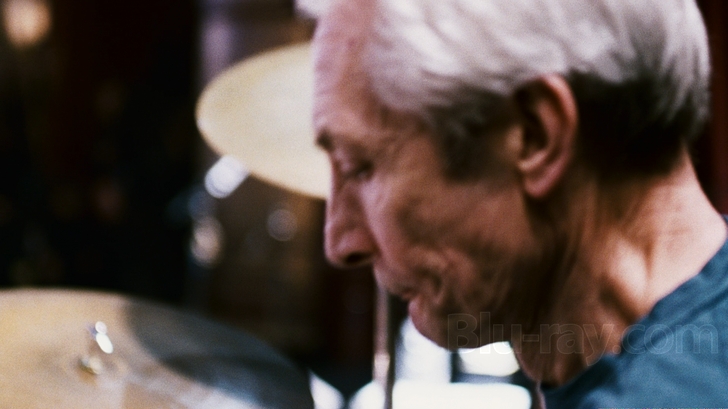
The bonus material is light on quantity but heavy on quality. At a time when studios are padding their supplementary content with audio commentary and standard definition featurettes, Paramount has taken a preferable approach with Shine a Light, with only high definition content included: a 16-minute collection of interviews and rehearsal clips left on the cutting room floor, and four extra songs: "Paint It Black", "Little T and A", "I'm Free" and "Undercover of the Night". All this content is produced in 1080p using MPEG-4 with a Dolby TrueHD 5.1 track at 24-bit, 48 kHz. Stones fanatics should be sure to check out all of it. Fans of Scorsese would prefer audio commentary or a "making of" documentary, but no such material is included. While it would have been nice to hear from Scorsese, I think the bonus material holds its own without it.
Shine a Light Blu-ray Movie, Overall Score and Recommendation 
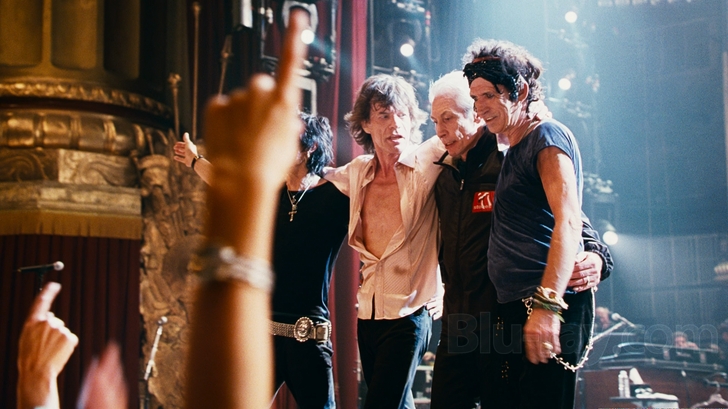
Have you ever seen concert footage that forced you to watch an artist's fingers on the guitar when you wanted to see his face or showed his face when you wanted to see his fingers on the guitar? That pulled in tight when you wanted to see a wider shot or that lingered on a wide shot when you wanted to see a close-up? We all have. Let's face it: most concert footage sucks. Led Zeppelin's The Song Remains the Same is a prime example. But with Shine a Light, a new standard has been achieved for rock concert footage. It may have taken some of the most talented cinematographers currently working, but Scorsese has achieved the ultimate approach to capturing a dynamic band performing onstage. The cameras never stop moving, yet the angles and views of the band maintain perfection at all times. We see exactly what we need to see--no more and no less. And that presence--even more than the band or the music itself--is what makes Shine a Light such an important achievement.
Other editions
Shine a Light: Other Editions
Similar titles
Similar titles you might also like

The Rolling Stones: The Biggest Bang
2007

Rock & Roll Hall of Fame Concerts
25th Anniversary
2009-2010

The Police: Certifiable
2008

U2: 360° at the Rose Bowl
U2360° at the Rose Bowl
2009

Ladies and Gentlemen: The Rolling Stones
1973

Queen Rock Montreal & Live Aid
1981

The Song Remains the Same
Led Zeppelin
1976

Woodstock: 3 Days of Peace & Music
Director's Cut | 40th Anniversary Edition
1970

Bruce Springsteen & The E Street Band: London Calling: Live In Hyde Park
2009

David Gilmour - Remember That Night - Live At The Royal Albert Hall
2007

The Beatles: Eight Days a Week - The Touring Years
Deluxe Edition | ~90m Bonus disc
2016

U2: Rattle and Hum
1988

Eric Clapton's Crossroads Guitar Festival 2013
2004-2013

The Who at Kilburn: 1977
1977

Rush: Snakes and Arrows Live
2008

Springsteen & I
Bruce Springsteen
2013

When You're Strange: A Film About The Doors
2009

LennoNYC
Lennon NYC
2010

The Last Waltz
1978

The Wrecking Crew
2008

